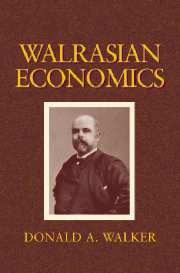Book contents
- Frontmatter
- Contents
- Preface
- Introduction
- Part I Walras's ideas
- Part II Walras's influence
- 9 Models constructed by Walras's contemporaries and immediate successors
- 10 Models drawing upon the heritage of the written pledges sketch, 1930 to 1971
- 11 Concluding comments: Walras's ideas in modern economics
- References
- References and Bibliography for Chapter 11
- Index
10 - Models drawing upon the heritage of the written pledges sketch, 1930 to 1971
Published online by Cambridge University Press: 02 September 2009
- Frontmatter
- Contents
- Preface
- Introduction
- Part I Walras's ideas
- Part II Walras's influence
- 9 Models constructed by Walras's contemporaries and immediate successors
- 10 Models drawing upon the heritage of the written pledges sketch, 1930 to 1971
- 11 Concluding comments: Walras's ideas in modern economics
- References
- References and Bibliography for Chapter 11
- Index
Summary
Introduction
The previous chapter has explored the first phase of the realization of Walras's prediction that subsequent economists would draw upon his mature comprehensive model, the second phase being considered in Chapter 11. The present chapter examines the aspects of his written pledges sketch accepted by general equilibrium theorists after 1929, and that, in accordance with their interpretations of that sketch, formed the starting point of their own contributions and influenced their ongoing research.
There is a need for the clarification undertaken in this chapter of aspects of the history of general equilibrium theorizing, as a brief preview of some of those aspects demonstrates. Mark Blaug remarked that, “It was (Henry) Schultz, Hicks, Hotelling, Lange and Samuelson who were responsible in the golden decade of the 1930s in bringing about this revival of GE theory” (Blaug 1997, p. 253; and see Arrow 1968, p. 380). That statement should be qualified. In the first place, it does not take account of most of the major developments in general equilibrium theorizing in the 1930s, namely of those that took place outside of the United States and England, a matter that will be discussed shortly. Second, a number of qualifications can be made about the precise contributions and dates of the work of the scholars Blaug mentioned. It was in the 1920s that Henry Schultz sustained the vitality of the Walrasian non-virtual tradition and was joined by others.
- Type
- Chapter
- Information
- Walrasian Economics , pp. 288 - 312Publisher: Cambridge University PressPrint publication year: 2006



